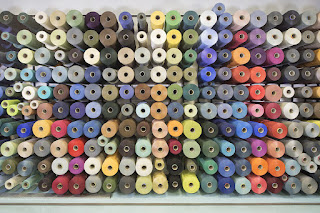ECONYL® regenerated nylon is a truly innovative and futuristic fabric; it is made from waste, it's infinitely recyclable and can unleash infinite possibilities for makers, creators and consumers. It's all part of the ECONYL® brand vision to make the world a better place by pioneering closed loop regeneration processes and delivering sustainable products.
After four years of tireless research and development, a relentless innovator, managed to see his dream come to reality. "When I see a landfill, I see a goldmine", says Giulio Bonazzi, CEO and president of Aquafil, a global leader in synthetic fibres and a pioneer in quality, innovation and sustainability.
What is Econyl?
ECONYL® yarn is recycled nylon. Nylon is created artificially using plastic to form strands of thread which are then woven together to create fabrics. As it is made of plastic, it doesn't biodegrade therefore its use is a major concern for the environment.
How is it made?
ECONYL® is made by first collecting nylon waste including carpets, ghost fishing nets and scraps from mills. Then there is a regeneration and purification process where the collected nylon waste is recycled back to its original purity. After that the regenerated nylon is processed into textile yarn which can be used for new fabric and materials for designers to utlize in their own creations.
What can be made out of ECONYL®?
The possibilities are endless. Apparel such as swim wear, jackets, sports wear, hand bags and other fashion accessories such as sunglasses - but also carpets, flooring, car interiors, sofas and cushions.
World-famous brand using ECONYL®
For pre-fall 2020-21 Gucci has developed Gucci Off The Grid, the first collection from Gucci Circular Lines, an initiative created to support the House’s vision for circular production. Designed for those mindful of their environmental impact, Gucci Off The Grid uses recycled, organic, bio-based, and sustainably sourced materials, including ECONYL®.
The new TOMMY JEANS eyewear collection, recently launched by Tommy Hilfiger, is the first that features styles made of ECONYL® regenerated nylon. The brand is using recycled materials in an effort to a promote a responsible business. Their intention is to expand the use of ECONYL® as much as possible in order to decrease their carbon footprint.”
Burberry has launched a new capsule collection crafted with ECONYL® yarn. Burberry’s heritage is anchored in material innovation, from the invention of gabardine – a breathable, weatherproof and hardwearing fabric – by Thomas Burberry in 1879 – to its use of innovative materials today. The ECONYL® yarn collection is one example of the 50 disruptions Burberry is making throughout its supply chain to create a more sustainable future for fashion.
Super proud of our own CHURPINA, a Maltese swim-wear designer and creator who uses ECONYL® regenerated nylon in her pieces. Self-taught seamstress Charlene Joan Sant creates elegant and playful pieces full of beautiful summery prints and cute names like 'Dawra Durella' and 'Qabza Zigarella'. Her approach towards sustainability carries on beyond the product as she packages her swimwear in re-usable branded string bags and uses bio-degradable material for overseas packaging. Discover Churpina: https://www.churpina.com/



A 2,000-square-meter “green carpet” was the star center-piece for the third annual Green Carpet Fashion Awards in Milan, made of Econyl, its yarn made of regenerated nylon created from discarded fishing nets and other nylon waste. The Green Carpet Fashion Awards are an annual event, with 2019 hosting the third edition, celebrating the industry's engagement with sustainability, climate change and social responsibility. The GCFA awards are granted to members of the fashion community effectively embrancing real changes in the system's production chain - reducing waste, finding alternatives to plastic, protecting small sustainable businesses and innovatio and research. less planet-harmful technologies and innovations.
Images credit: ECONYL.COM, CHURPINA.COM, NATUREEPI.COM















No comments:
Post a Comment